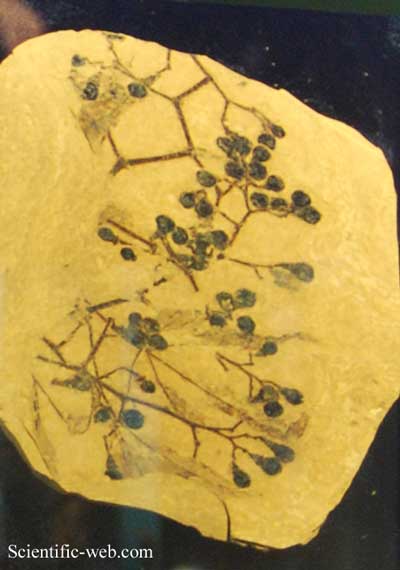
Theaceae sp. Fossil, Photo: Michael Lahanas
Cladus: Eukaryota
Regnum: Plantae
Divisio: Magnoliophyta
Classis: Magnoliopsida
Ordo: Ericales
Familia: Theaceae
Tribus: Gordonieae - Stewartieae - Theeae
Genera: Apterosperma - Camellia - Franklinia - Gordonia - Laplacea - Polyspora - Pyrenaria - Schima - Stewartia - Tutcheria
Name
Theaceae Mirb. ex Ker Gawl., Ker Gawl. in Bot. Reg. 2: ad t. 112. 1816, nom. cons.
Synonyms
* Camelliaceae Mirb. in A.P. de Candolle, Essai Propr. Méd. Pl., ed. 2: 978. 11 1816
* Gordoniaceae DC. in Spreng., Syst. Veg. 3: 12. 1826.
* Malachodendraceae J. Agardh, Theoria Syst. Pl.: 130. 1858, nom. illeg.
Excluded or synonymous taxa
Dankia
References
* Royal Botanic Gardens, Kew. Vascular Plant Families and Genera List of genera in family Theaceae (includes Pentaphylacaceae within Theaceae)
* Stevens, P. F. (2001 onwards). Angiosperm Phylogeny Website. Version 6, May 2005. Theaceae (treats Pentaphylacaceae separately)
* Flora of China (draft) Theaceae
Vernacular names
Internationalization
Български: Чаеви
Dansk: Te-familien
Deutsch: Teestrauchgewächse
Esperanto: Teacoj
日本語: ツバキ科
中文: 山茶科
The Theaceae is a family of flowering plants, composed of shrubs and trees. Some botanists include the family Ternstroemiaceae within the Theaceae[2] while others do not.[3] Theaceae can be described as having anywhere from 7-40 genera, depending on the source and the method of circumscription used.
Family Characteristics
Plants in this family are characterized by simple leaves that are alternate spiral to distichial, serrated, and usually glossy. Most of the genera have evergreen foliage, but Stewartia and Franklinia are deciduous. The toothed margins are generally associated with a characteristic Theoid leaf tooth, which is crowned by a glandular, deciduous tip. [4]The flowers in this family are usually pink or white and large and showy, often with a strong scent. [5] The calyx consists of five or more sepals, which are often persistent in the fruiting stage, and the corolla is five-merous, rarely numerous. Plants in Theaceae are multistaminate, usually with 20-100+ stamen either free or adnate to the base of the corolla, and are also distinctive because of the presence of pseudopollen. The pseudopollen is produced from connective cells, and has either rib-like or circular thickenings. The ovary is often hairy and narrows gradually into the style, which may be branched or cleft. The carpels are typically opposite from the petals, or the sepals in the case of Camellia. The fruits are loculicidal capsules, indehiscent baccate fruits or sometimes pomes. The seeds are few and sometimes winged, or in some generas covered by fleshy tissue or unwinged and nude. 3,4
Chemistry
There is distinctive chemistry within the Theaceae family. Sometimes, single crystals of calcium oxalate are present in Theaceous plants. Ellagic acid and common polyphenols including flavonols, flavones and proanthocyanins are widely distributed throughout the family. Gallic acid and catechins only occur in Camellia sect. Thea (C. sinensis, C. taliensis and C. irrawadiensis. Caffeine and its precursors theobromine and theophylline are only found in sect. Thea and are not found in other species of Camellia or other Theaceae. Caffeine content in the tea bush makes up 2.5-4% of the leave's dry weight, and this high content of catechins and caffeine in the tea bush is the result of selection by man for these characters. Triterpenes and their glycosides (saponins) are found widely throughout the family in the seeds, leaves, wood and bark. Plants in this family are also known to accumulate aluminum and fluoride.3
Distribution
Eleven genera are found only in east Asia (Malesia north to Japan), with several genera in Central and South America. Three genera are found only in Africa, and two genera are only found in the Neotropics.4 Three genera (Franklinia, Gordonia and Stewartia) also have species native to the southeastern United States, with Franklinia being endemic there, and under recent interpretations, also Gordonia with the Asian species formerly included in that genus being transferred to Polyspora.[6] There are five genera with very restricted distributions. These include Apterosperma and Euryodendron found in Southern China, Archboldiodendron found in New Guinea, Dankia found in Vietnam, and Visnea in the Canary Islands and Madeira. 4
Economic Importance
The best known genus is Camellia, which includes the plant whose leaves are used to produce tea (Camellia sinensis). In parts of Asia, other species are used as a beverage, including C. taliensis, C. gradnibractiata, C. kwangsiensis, C. gymnogyna, C. crassicolumna, C. tachangensis, C. ptilophyllaand, and C. irrawadiensis. [7] Several species grown widely as ornamentals for their flowers and handsome foliage.
External links
1. ^ Germplasm Resources Information Network (GRIN) entry for Camelliaceae
2. ^ Royal Botanic Gardens, Kew. Vascular Plant Families and Genera: Theaceae
3. ^ Watson, L., & Dallwitz, M. J. (1992 onwards). The families of flowering plants. Theaceae
4. ^ Stevens, P.F. 2003. Clusiaceae. In: Kubitzki, K. (Eds.), The Families and Genera of Vascular Plants. Springer, Hamburg, Germany
5. ^ Luna I, Ochoterena H (2004) ‘Phylogenetic relationships of the genera of Theaceae based on morphology.’ Cladistics Vol. 20 223-270
6. ^ Flora of China Theaceae (draft)
7. ^ Chang, H.T., Bartholomew, R.C. 1984. Camellias. Timber Press, Portland, OR
Retrieved from "http://en.wikipedia.org/"
All text is available under the terms of the GNU Free Documentation License

